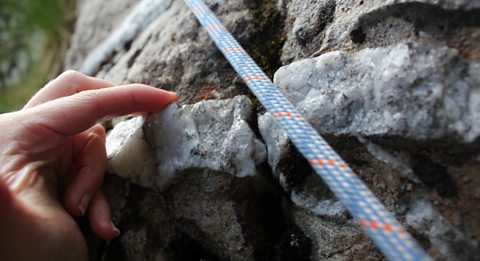Geologist and keen climber Dr Tom Challands challenges a pair of young people each to climb a rock face and see just what can be revealed from this unique vantage point, on the rock face rather than observing from the ground.
The climbs are not only technically demanding but throw up different field study challenges for the team to solve.
This location is the beautifully eerie Roaches in the Peak District National Park, Staffordshire.
Our climbers face damp conditions making their climb very slippy.
They are faced with uncovering evidence which should tell them under which conditions The Roaches were formed.
Can they say if the rock landforms are the still the same way up as they originally were?
This clip is from the series Rock Types at Great Heights.
Teacher Notes
Could be used to introduce elements of the geology, geography and earth science syllabus, or in preparation for field studies.
Prior to watching the clip, students could be encouraged to discuss what they know about gritstone and sandstone, and how they would go about identifying how the rocks were formed, for example, grain size and bedding plains.
They can then watch the clip and see if their predictions were accurate, and make comparisons between their ideas and the methods adopted in the field.
Curriculum Notes
This clip will be relevant for teaching GCSE Geography and Social Studies. This topic appears in OCR, AQA, Edexcel, WJEC KS4/GCSE in England and Wales, CCEA GCSE in Northern Ireland and SQA National 4/5 in Scotland.
More from Rock Types at Great Heights
Castle Inn Quarry (Snowdonia National Park) video
Two young people climb Castle Inn Quarry to study geology from a unique vantage point.

How the Cwm Idwal slabs were affected by tectonic activity. video
Two young people climb the Cwm Idwal slabs to study geology from a unique vantage point.
